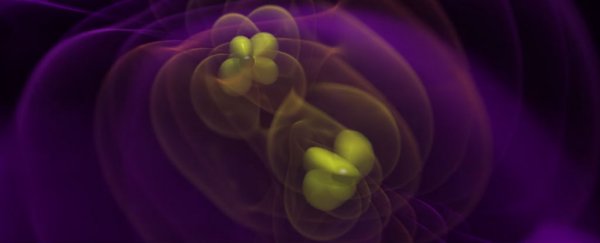Less than half a second after the first direct evidence of gravitational waves was recorded on 14 September 2015, a very short, faint signal was registered by NASA's Fermi Telescope from the same region in space.
High-energy light particles called gamma rays were caught emanating from a black hole merger in the area, and the discovery will not only help physicists pinpoint the exact source of the gravitational wave - if confirmed, it has huge implications for our understanding of the fundamental physics that govern our Universe.
"Gamma-rays arising from a black hole merger would be a landmark finding because black holes are expected to merge 'cleanly', without producing any sort of light," NASA explains.
First off, here's what we know. On September 14, the Laser Interferometer Gravitational-Wave Observatory (LIGO) facilities in Washington and Louisiana picked up the first direct evidence of Einstein's gravitational waves, traced to the merging of two black holes (called binary black holes) around 1.3 billion years ago.
The discovery was significant for two reasons, as Fiona MacDonald reported for us earlier this year:
"This event - which in itself is a big deal, seeing as no one had ever spotted a binary black hole merger before - was so massive that it significantly warped the fabric of space time, creating ripples that spread out across the Universe… finally reaching us last year."
Now, researchers at NASA have just announced that they too picked up on something strange on September 14 - a very faint burst of gamma rays that occurred less than half a second after the gravitational waves, and in the same region of space.
Coincidence? We can't discount it just yet, but NASA says there's a 0.2 percent chance of these two events randomly occurring in the same place at the same time.
At the very least, the discovery - which was picked up by the Gamma-ray Burst Monitor (GBM) on NASA's Fermi Gamma-ray Space Telescope - will help scientists figure out exactly where this black hole merger occurred 1.3 billion years ago.
"Currently, gravitational wave observatories possess relatively blurry vision. For the September event, dubbed GW150914 after the date, LIGO scientists could only trace the source to an arc of sky spanning an area of about 600 square degrees, comparable to the angular area on Earth occupied by the United States.
Assuming the GBM burst is connected to this event, the GBM localisation and Fermi's view of Earth combine to reduce the LIGO search area by about two-thirds, to 200 square degrees."
 Map of the original source of the September 14 gravitational wave event, which has now been narrowed down by two-thirds. Credit: LIGO/Axel Mellinger
Map of the original source of the September 14 gravitational wave event, which has now been narrowed down by two-thirds. Credit: LIGO/Axel Mellinger
But the fact that light appears to have been emitted from a black hole merger could also prompt a massive rethink of one of the most violent, high-energy events in the known Universe.
Why? Well, simply put, gas is needed in order to generate light, and there should be no gas around two soon-to-merge black holes, because it should have been swallowed up by one of them long before the pair collide.
There are now two possibilities. The first is the gamma ray burst really was a coincidence and wasn't related to the GW150914 black hole merger that produced the September 14 gravitational waves. The second is that black hole mergers really can produce an observable gamma-ray emission, and that means we're going to have to rethink the laws that govern what black holes can swallow and when.
"This is a tantalising discovery with a low chance of being a false alarm, but before we can start rewriting the textbooks we'll need to see more bursts associated with gravitational waves from black hole mergers," one of the the GBM team, Valerie Connaughton, told Francis Reddy at Phys.org.
We're now going to need more data to figure out which, but gas particles escaping the pull of black holes? That would be pretty damn amazing.
The results have been published in The Astrophysical Journal.
